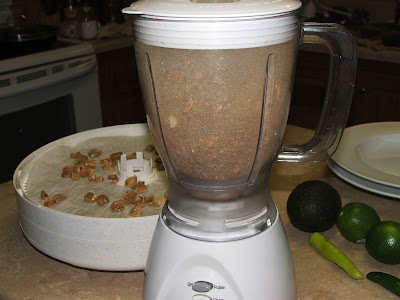Garden mint is taking over my little corner of the world! I've been on a quest to find new ways to use this wonderfully aromatic herb. Happened upon a recipe while looking for different pesto recipes and had to give it a try.
2 cups mint leaves
1/2 cup walnuts
1/3 cup honey
1 Tbsp. vanilla extract
So out to the herb bed I went and I snipped and snipped, hardly making a dent in the abundance of mint (I think that just rhymed somehow!).
I rinsed my mint and shook it dry...
Then stripped all the leaves off into a measuring bowl...
I had four cups of mint leaves if I pressed down on them.
 |
| Pay no attention to all the squash in the background... it is also trying to take over my world! |
So, I doubled the recipe... In my blender I combined the mint leaves...
With the walnuts (any nut will do... Mmmmm Macadamia would be yummo! But I had walnuts... which are yummy too!
I added the honey...
And the vanilla extract (which I made last year, by the way, and it's wonderful! I'll never go back to storebought vanilla! Never!)
Then I blended it all up! This took a little doing and I almost grated the handle of a wooden spoon in there a time or two... but at last I got it all blended and smooth... Oh the SMELL!!!! I wish you could smell the smell!!! Too bad we don't have smeller-net!
Then I poured (and scraped) it into a couple of freezer cups to store in the freezer (kept some out for eating NOW!)
My imagination is going WILD thinking of things to do with this stuff... I'm thinking sandwiched between two chocolate cookies... stirred in chocolate ice cream... as a filling between two layers of chocolate cake... (am I seeing a chocolate theme here or is that just my imagination?) or just with a spoon right out of the cup (well maybe not, but it's really really good!)














































